DOWNLOAD NEWS 2014/13
by Brian Wilson and Geoffrey Molyneux
Reviews are by Brian Wilson except where otherwise
stated.
2014/12 is here and the index of earlier editions to the end of 2013 is here.
Index to 2014/13:
AGRICOLA, JOSQUIN, MOUTON A Spy's Choirbook_Alamire_Obsidian
BECK Sinfonias, Op.4_ Štilec_Naxos
BEETHOVEN Piano Concertos 3 and 4_Pires/Harding_Onyx
-do- Perahia/Haitink_Sony
Compared with Kempff/van Kempen (Naxos) and other recordings
Symphonies 2 and 8_Gardiner (live)_SDG
Violin Sonatas 2 and 4; Piano Trios 3 and 5_Staier, etc_Harmonia Mundi
+ HUMMEL
BRAHMS Symphonies 3 and 4_Gergiev_LSO Live
Bruno Walter conducts Brahms_Sony
BRUCH Violin Concerto 2; Scottish Fantasy_Weithaas_CPO
BRUMEL Missa de beata virgine_Brabant E_Hyperion
BUSNOIS Missa O crux lignum_Orlando Consort_Harmonia Mundi
CHRISTMAS RECORDINGS
Baroque Christmas (Bach family, Telemann, etc)_Capriccio
Christmas at the Court of the Salzburg Archbishop_ Salzburger Hofmusik_Profil
Christmas Cantatas of 18th-century Gdansk_Sarton
Festive Baroque Christmas (SCHÜTZ, etc)_Harmonia Mundi
Medieval Christmas_Orlando Consort_Harmonia Mundi
Missa Conceptio Tua (de la RUE), etc._Schola Antiqua of
Chicago_Naxos
PALESTRINA Missa Hodie Christus natus est_Westminster
Cath._Hyperion Helios
Veillée de Noël de la France à l'Acadie (la)_Leblanc_Atma
Venetian Christmas (VIVALDI, etc)_ L'Arte dei Suonatori_BIS
CORELLI Concerti Grossi, Op.6_Gli Incogniti_ Zig-Zag + VIVALDI
Seasons
DEBUSSY Images, Préludes_Hamelin_Hyperion
FALLA Noches en los Jardines de España, etc_Pérez_Mirare
El amor brujo, Noches en los Jardines_Fingerhut/Simon_ChandosGLUCK
Don Juan_Antonini_Alpha + HAYDN
HAYDN Concertos for Trumpet, Keyboard and Violin and Cello in
D_Beulah Korea
Symphonies 1, 39 and 49_Antonini_Alpha + GLUCK
HUMMEL Piano Trio No.4_ Staier, etc_Harmonia Mundi + BEETHOVEN
ISTVÁNFFY Mass for St Benedict_Vashegyi_Hungaroton + KRAUS
JANÁČEK Glagolitic Mass_Netopil_Supraphon
Glagolitic Mass_Svarovsky_ArcoDiva
JOSQUIN, MOUTON A Spy's Choirbook_Alamire_Obsidian + AGRICOLA
KRAUS Overtures and Arias_ Häkkinen_Naxos
Requiem_ Vashegyi_Hungaroton + ISTVÁNFFY
MAHLER Das Lied von der Erde_Carlos Kleiber_Wiener Symphoniker
MOZART String Quintet, K516_Léner Quartet, etc._Beulah
NIELSEN Symphony No.2_Grøndahl_Beulah
Symphony No.4_Grøndahl_Naxos Archives
PALESTRINA Missa Hodie Christus natus est (see Christmas
Recordings)
PROKOFIEV Romeo and Juliet Suite_Muti_CSO Resound
RIMSKY KORSAKOV Scheherazade_Goossens_Everest (also 2013/15)
SHOSTAKOVICH Symphony No.13_Petrenko_Naxos
STAMITZ, Carl Clarinet Concertos_Brunner_Tudor
VAUGHAN WILLIAMS Concertos_Sillito, etc_Thomson_Chandos
Symphony 4; Violin Concerto_Sillito_Thomson_Chandos
Symphonies 5 and 7_Haitink_LPO
VIVALDI Four Seasons, etc._Gli Incogniti_Zig-Zag + CORELLI Op.6
Four Seasons, etc._Nishizaki_2xHD
Compared with Loveday (Decca) and Biondi (Erato)
WARD Fantasias and Verse Anthems_Phantasm_Linn
WECKMANN Complete Organ Works_Foccroulle_Ricercar
-do- Flamme_CPO
***
Antoine BRUMEL (c1460–1512/13)
Nato canunt omnia a5 [8:19]
Beata es, Maria a4 [4:11]
Lauda Sion Salvatorem a4 [14:03]
Ave cœlorum Domina a4 [4:04]
Missa de beata virgine a4 [33:21]
The Brabant Ensemble/Stephen Rice
rec. St Michael and All Angels, Summertown, Oxford, August 2013. DDD
pdf booklet with texts and translations included
HYPERION CDA68065 [63:56] – from hyperion-records.co.uk (mp3, 16- and 24-bit lossless)
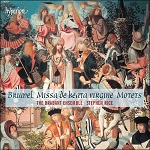 This
new recording moves us on from Brumel’s ‘Earthquake’ Mass, a remarkable
work but now we’re almost spoiled for choice, with fine recordings from
The Tallis Scholars (Gimell, various combinations), the Huelgas Ensemble
(Newton Classics), Studio de musique ancienne de Montréal (Atma), Ensemble
Clément Janequin (Harmonia Mundi, deleted), Hilliard Ensemble (Coro)
and The Sixteen (Gloria and Sanctus: Coro).
This
new recording moves us on from Brumel’s ‘Earthquake’ Mass, a remarkable
work but now we’re almost spoiled for choice, with fine recordings from
The Tallis Scholars (Gimell, various combinations), the Huelgas Ensemble
(Newton Classics), Studio de musique ancienne de Montréal (Atma), Ensemble
Clément Janequin (Harmonia Mundi, deleted), Hilliard Ensemble (Coro)
and The Sixteen (Gloria and Sanctus: Coro).
The programme opens with the Christmas motet Nato canunt omnia Domino (Let all things sing to the new-born Lord), with lots of Noëls at the end of each section. It’s aptly described in the notes as a
remarkable work and it gets the album off to a flying start. I could
almost have included it with the Christmas selection (below).
There’s one other recording of the main work, Missa de beata virgine,
from Speculum Ensemble on Naxos 8.570535. That’s attractive
enough heard on its own but slow, bottom-heavy and rather dutiful, especially
in the Gloria (10:07 as against 7:35) by comparison with the
new recording, adding almost seven minutes overall to the Brabant Ensemble’s
33:21 – try it from Qobuz or Naxos
Music Library. My clear preference lies with the brighter and lighter
Hyperion. If you are happy with CD-quality 16-bit, the price of £7.99
is not much more than you would pay for the Naxos; 24-bit comes at a
reasonable premium.
The performances are all that we have come to expect from the Brabant
Ensemble – as near perfect as it’s possible for unaccompanied singing
to be: the inevitable but very occasional insecurity is of no account.
The recording sounds slightly recessed after the Naxos, but a small
volume lift takes care of that, and the booklet is of the usual high
Hyperion standard – you’ll need to consult it even if you are familiar
with the Latin text of the Mass, as the Gloria contains some
farced sections, additions in praise of the Virgin Mary. The Naxos
notes are also worth reading if you have access to Naxos Music Library.
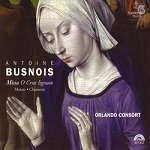 You’ll
find a recording by the Orlando Consort of medieval music in
the Christmas section at the end of this edition. They also recorded Antoine BUSNOIS (c.1430-1492) Missa O crux lignum for
Harmonia Mundi – music related to Passiontide, not Christmas – together
with Latin motets and French chansons on Harmonia Mundi HMU907333.
There are no texts and the album has been reissued in the budget Musique
D’Abord series for around £7, but the D’Abord releases usually come
without texts, too, and the eclassical.com price of $11.25 for mp3 and lossless works out about the same as the
budget CD reissue. Those happy with 320kb/s mp3 or m4a will find the
D’Abord reissue for £4.49 from7digital.com.
Stream from Qobuz.
You’ll
find a recording by the Orlando Consort of medieval music in
the Christmas section at the end of this edition. They also recorded Antoine BUSNOIS (c.1430-1492) Missa O crux lignum for
Harmonia Mundi – music related to Passiontide, not Christmas – together
with Latin motets and French chansons on Harmonia Mundi HMU907333.
There are no texts and the album has been reissued in the budget Musique
D’Abord series for around £7, but the D’Abord releases usually come
without texts, too, and the eclassical.com price of $11.25 for mp3 and lossless works out about the same as the
budget CD reissue. Those happy with 320kb/s mp3 or m4a will find the
D’Abord reissue for £4.49 from7digital.com.
Stream from Qobuz.
 John
WARD (c.1589-1638) Fantasias 1-6 for 4-part viols and Verse Anthems:Praise
the Lord, O my soul; Mount up, my soul; Down, caitiff wretch; How long
with thou forget me, Lord; Let God arise and This is a joyful,
happy day are performed by Phantasm and the Choir of Magdalen
College, Oxford, directed by Daniel Hyde on Linn CKD427 [59:46], recorded in May 2013. Download from linnrecords.com or hyperion-records.co.uk (mp3, 16- and 24-bit lossless, with pdf booklet containing texts).
Phantasm had already recorded Ward’s 5- and 6-part consort music (CKD339: Recording of the Month – review and October
2009) and have a number of other recordings of the music of the
period to their credit.
John
WARD (c.1589-1638) Fantasias 1-6 for 4-part viols and Verse Anthems:Praise
the Lord, O my soul; Mount up, my soul; Down, caitiff wretch; How long
with thou forget me, Lord; Let God arise and This is a joyful,
happy day are performed by Phantasm and the Choir of Magdalen
College, Oxford, directed by Daniel Hyde on Linn CKD427 [59:46], recorded in May 2013. Download from linnrecords.com or hyperion-records.co.uk (mp3, 16- and 24-bit lossless, with pdf booklet containing texts).
Phantasm had already recorded Ward’s 5- and 6-part consort music (CKD339: Recording of the Month – review and October
2009) and have a number of other recordings of the music of the
period to their credit.
The vocal works nicely supplement Ward’s two laments for Price Henry
(SIGCD210 – review).
I don’t believe any of the anthems on the new album have been recorded
anywhere else, which is no reflection on their quality – well worth
hearing alongside the better-known choral music of the period from the
likes Orlando Gibbons – and the fantasias are just as attractive as
the viol works on the earlier recording. After a slightly shaky start
from the exposed higher voices in Praise the Lord and Down,
caitiff wretch, the quality of the singing serves as a reminder
that Magdalen College Choir deserve to be heard more often on record.
A word of caution: both Linn and Hyperion charge £8.00 for mp3 and £10
for 16-bit lossless, but I’ve seen one supplier asking £12.87 for mp3.
Don’t go there. The 24-bit versions are rather pricey at £18 when you
can buy the SACD from Linn for £13 – slightly less from some suppliers.
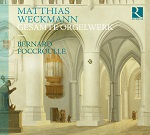
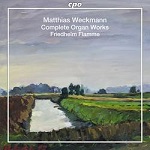 Two
recordings of the complete organ music of Matthias WECKMANN (c.1616-1674) have appeared almost simultaneously. On Ricercar RIC348 2CDs
[73:19 + 61:02] Bernard Foccroulle performs on three historic
organs: in Hollern, Stade, and primarily on the recently restored organ
of the Katharinen Kirche in Hamburg. This recording completes Ricercar’s
contribution to the availability of all Weckmann’s extant works, with
his cantatas on RIC216 and his instrumental music on RIC282. There’s
a trailer on YouTube here.
Two
recordings of the complete organ music of Matthias WECKMANN (c.1616-1674) have appeared almost simultaneously. On Ricercar RIC348 2CDs
[73:19 + 61:02] Bernard Foccroulle performs on three historic
organs: in Hollern, Stade, and primarily on the recently restored organ
of the Katharinen Kirche in Hamburg. This recording completes Ricercar’s
contribution to the availability of all Weckmann’s extant works, with
his cantatas on RIC216 and his instrumental music on RIC282. There’s
a trailer on YouTube here.
I enjoyed Foccroulle’s recording of the music of Georg Böhm (RIC319 – February
2012/2) and I also enjoyed this recording of an even earlier predecessor
of Bach. All three organs chosen are well suited to the music. My
review copy from Outhere was at the low bit-rate of 192kb/s and, oddly,
at 48kHz, but sounded well enough for me to predict that when this recording
appears commercially, in mid November 2014, it will be competitive.
The other recording, on CPO, is already available. It features Friedhelm Flamme at the Johann-Patroclus-Möller organ of the
Abteikirche Marienmünster, restored in 2012: Volume 12 of their Organ
Works of the North German Baroque series (7778732 2 hybrid
SACDs [60:45 + 55:18]) – from eclassical.com (mp3 and lossless, with pdf booklet). Flamme’s organ and his chosen
registration are a little more up-front than Foccroulle’s and the recording
sounds firmer – but remember the limitations of my review download of
the Ricercar. The difference is enhanced because Flamme opens with
one of the more dramatic pieces, the Preambulum primi toni, which
Ricercar leave until CD2, where Foccroulle takes it a shade more slowly.
I suspect that the organ specialist will prefer the Ricercar recording
on the kind of North German organ that Weckmann would have known, the
general music lover the CPO.
Reissue of the Month .

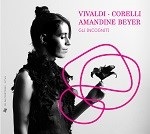 It
seems – it is – only a short time since I was one of those who praised
the complete Op.6 concertos of Arcangelo CORELLI (1653-1713) from Gli Incogniti on Zig-Zag Territoires – review – review and 2014/3.
Now that recording, directed by Amandine Beyer, has already been reissued
on a 4-CD set together with The Four Seasons and other concertos,
mostly for violin and orchestra, by Antonio VIVALDI. (ZZT349 [Total time: 4:49:45]). The Vivaldi tracks come from ZZT310 – review – and ZZT080803 and the reissue deserves the highest praise. There’s
no contest between this version of the Seasons and the Nishizaki/Gunzenhauser
below.
It
seems – it is – only a short time since I was one of those who praised
the complete Op.6 concertos of Arcangelo CORELLI (1653-1713) from Gli Incogniti on Zig-Zag Territoires – review – review and 2014/3.
Now that recording, directed by Amandine Beyer, has already been reissued
on a 4-CD set together with The Four Seasons and other concertos,
mostly for violin and orchestra, by Antonio VIVALDI. (ZZT349 [Total time: 4:49:45]). The Vivaldi tracks come from ZZT310 – review – and ZZT080803 and the reissue deserves the highest praise. There’s
no contest between this version of the Seasons and the Nishizaki/Gunzenhauser
below.
My only criticism is that the Outhere group, under whose wing Zig-Zag
recordings are produced, tempted lovers of baroque music to buy the
2-CD Corelli set when the better-value 4-disc set was only months away.
If you held back before, go for it now.
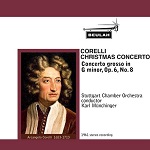
A reissue from Beulah brings us an unexpectedly welcome reminder of
an earlier approach to Corelli (1BX250, from eavb.co.uk).
Like most of my generation I got to know Vivaldi from the Decca recordings
made by Karl Münchinger with his Stuttgart Chamber Orchestra, but he
also introduced us to other baroque repertoire, including the CORELLI
Concerto Grosso, Op.6/8, known as the ‘Christmas’ concerto because
of its pastoral slow movement. I expected this recording to sound ponderous
in the bad old style, but Münchinger did move with the times and by
1961 his performances were more sprightly. At 14:08 overall, this is
only a fraction slower than Gli Incogniti, so only outright authenticists
will find it unstylish. The stereo sound is more bottom-heavy than
we are accustomed to now in this repertoire, but that’s down to Münchinger
rather than the recording transfer.
Antonio VIVALDI (1678-1741)
The Four Seasons, Op.8/1-4 [41:38]
Concerto alla rustica in G, RV151 [4:28]
Takako Nishizaki (violin); Capella Istropolitana/Stephen Gunzenhauser
rec. Concert Hall of the Slovak Philharmonic, July 1987. DDD.
pdf booklet included
2xHD 2xHDNA2045 [45:15] – from eclassical.com (mp3, 16- and 24-bit lossless)
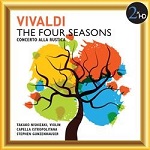 Any
recording of The Four Seasons has to be very special to shine
in a very competitive market and the Naxos recording with Takako Nishizaki
as soloist, good as it is, is hardly special. The performers hardly
put a foot wrong and sometimes they offer a novel insight into a particular
passage, but, even among recordings with modern instruments, compare
them overall with Alan Loveday, the Academy of St Martin’s and Neville
Marriner and you enter a world of much greater originality. (Decca
Originals 4757531.) The booklet, reproduced from the Naxos original,
comes with notes by Keith Anderson, but these hardly compensate.
Any
recording of The Four Seasons has to be very special to shine
in a very competitive market and the Naxos recording with Takako Nishizaki
as soloist, good as it is, is hardly special. The performers hardly
put a foot wrong and sometimes they offer a novel insight into a particular
passage, but, even among recordings with modern instruments, compare
them overall with Alan Loveday, the Academy of St Martin’s and Neville
Marriner and you enter a world of much greater originality. (Decca
Originals 4757531.) The booklet, reproduced from the Naxos original,
comes with notes by Keith Anderson, but these hardly compensate.
The Naxos recording, however, has always been highly regarded in hi-fi
circles – I remember a review of a Roksan CD deck in 2000 where the
disc was used to test its capabilities. Now it appears in 24-bit format,
albeit at something of a price premium: $12.22 against $8.15 for mp3
and 16-bit, £4.99 for the mp3 download from classicsonline.com and around
£6 for the Naxos CD. The 24-bit offers good, clear sound, but nothing
vastly better than hearing the Naxos disc streamed in lossless sound
via Qobuz.*
In fact, I slightly preferred the greater sense of firmness heard thus
to the clarity of the 2xHD transfer.
The playing time is very mean, with the Concerto alla rustica adding just 4:28 to The Seasons, and though eclassical.com’s
per-second price policy takes care of that, be aware that there’s an
alternative coupling on Naxos of this version of The Four Seasons with three other concertos, adding up to 71 minutes (8.553219).
For a set of the Four Seasons on period instruments, together
with equally fine accounts of the Op.3 concertos, L’Estro Armonico,
look no further than Fabio Biondi with Europa Galante (budget-price
Erato/Virgin 6484082, 4 CDs – review).
Alternatively, Christopher Hogwood’s recording of the Seasons with Christopher Hirons, John Holloway, Alison Bury and Catherine Mackintosh
forms part of Baroque Era, a recent bumper box from Decca available
in two parts as downloads. The Seasons are in Volume II, 25
CDs: superb value for £8.49 (mp3) from 7digital.com or £11.56 (lossless)
from Qobuz – 2014/10.
The other bargain offering comes from Zig-Zag in the 4-CD set of Corelli
and Vivaldi (above).
* beware of a dud track 3 from Qobuz – I knew that Vaughan Williams’ Lark Ascending seems to be featured everywhere these days, but
with Vivaldi?
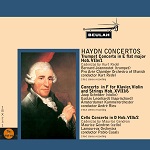 Three
concertos by Joseph HAYDN (1732-1809) make an attractive collection
from Beulah Korea (1BX231K – from kr.eavb.co.uk).
The Concerto for Trumpet in E-flat, Hob.VIIe/1 is performed by Beaumont
Jeannoutot (trumpet) with the Pro Arte Orchestra of Munich/Kurt Redel
(stereo, 1961); the Concerto in F for keyboard, violin and strings,
Hob.XVIII/6 by Gustav Leonhardt (harpsichord), Jaap Schröder (violin)
and the Amsterdam CO/André Rieu (stereo, 1963) and the Cello Concerto
in D, Hob.VIIb/2 by Maurice Gendron (cello) and the Lamoureux Orchestra/Pablo
Casals (stereo, 1960).
Three
concertos by Joseph HAYDN (1732-1809) make an attractive collection
from Beulah Korea (1BX231K – from kr.eavb.co.uk).
The Concerto for Trumpet in E-flat, Hob.VIIe/1 is performed by Beaumont
Jeannoutot (trumpet) with the Pro Arte Orchestra of Munich/Kurt Redel
(stereo, 1961); the Concerto in F for keyboard, violin and strings,
Hob.XVIII/6 by Gustav Leonhardt (harpsichord), Jaap Schröder (violin)
and the Amsterdam CO/André Rieu (stereo, 1963) and the Cello Concerto
in D, Hob.VIIb/2 by Maurice Gendron (cello) and the Lamoureux Orchestra/Pablo
Casals (stereo, 1960).
The double concerto formed part of one of the earliest Telefunken Das
Alte Werk LPs, not actually released until 1967 (SAWT9429) and though
ideas of period performance have changed since then, this lively account
still sounds attractive. The recording has come up sounding a little
over-bright, but that’s neither inappropriate to the music nor a major
problem. As it has never been reissued on CD to the best of my knowledge,
this makes the Beulah album especially welcome.
At the time of recording the Concerto in D was the only known Haydn
Cello Concerto – that in C was discovered a few years later – and this
was the performance from which I got to know it. The Philips Classical
Favourites CD on which it was available with Gendron’s later recording
of the Concerto in C is no longer available, so this Beulah release
is very welcome. The alternative release on the BnF label – Qobuz – comes with the original coupling, the now discredited Grützmacher
concoction of the Boccherini Cello Concerto. We now have more authentic
recordings of that, which means that the Beulah coupling is more attractive.
 Joseph
HAYDN (1732-1809) Symphonies Nos. 1, 39 and 49 (La Passione)
were recorded in October 2013 by Il Giardino Armonico/Giovanni Antonini
on Alpha 670 [70:52] – from classicsonline.com,
mp3, with pdf booklet for £4.99. The album, announced as the first
in a series in connection with the Haydn 2032 project, is completed
with GLUCK Don Juan. 16- and 24-bit lossless versions
are available for streaming and purchase from Qobuz.
Joseph
HAYDN (1732-1809) Symphonies Nos. 1, 39 and 49 (La Passione)
were recorded in October 2013 by Il Giardino Armonico/Giovanni Antonini
on Alpha 670 [70:52] – from classicsonline.com,
mp3, with pdf booklet for £4.99. The album, announced as the first
in a series in connection with the Haydn 2032 project, is completed
with GLUCK Don Juan. 16- and 24-bit lossless versions
are available for streaming and purchase from Qobuz.
The programme opens with Symphony No.39, one of the Sturm und Drang symphonies, for which Antonini’s exuberant manner, usually heard in
Italian baroque music, is just right. The opening sinfonia to
Gluck’s Don Juan which follows also benefits from a lively approach
but Antonini’s Giardino Armonico are also capable of playing grazioso when necessary, as in the following andante. A fine alternative
to the only two other recordings of this work from Neville Marriner
(Australian Eloquence) and Sir John Eliot Gardiner (Warner Apex or as
part of a 4-CD set). Antonini is surely justified in his assertion
that this ballet makes a good coupling for Haydn: the portrayal of Don
Juan’s descent to Hell could easily be a movement from one of the Sturm
und Drang symphonies.
Symphony No.49, another Sturm und Drang work, is unusual in opening
with an adagio. Antonini takes this faster than Gottfried von
der Goltz on a recent Harmonia Mundi budget reissue (HMA1952029).
I liked that performance – 2014/11 – but Antonini’s tempo for this movement works well, too. I defended
von der Goltz against the charge of driving too hard – a charge that
has sometimes been levelled against Antonini – and I’m happy to defend
Antonini from the same charge, except possibly in the Minuet and Trio,
which I think is taken just a little too fast, though with delicacy.
Antonini’s love of Haydn’s First Symphony – not exactly standard repertoire,
though I was surprised to find 15 recordings extant – stems from his
hearing Max Goberman’s recording with the VSOO, part of an uncompleted
project begun by CBS/Columbia. I have enjoyed hearing the recordings
from this series which have come my way – Nos. 6, 12-14 and 24 on Beulah 1PD55 and Nos. 41, 51 and 56 on Beulah 2PD55 – see 2013/2.
Hitherto my choice for this symphony has been Roy Goodman on Hyperion
Helios CDH55111 – Symphonies 1-5 – or Fischer on Nimbus NI5426-30,
5CDs, Nos. 1-20, both at bargain price and both reported on in July
2012/2. I preferred these to Patrick Gallois (Naxos) because his
fast tempi tend to slur the rhythms. Antonini takes the first two movements
marginally faster than Goodman and the finale marginally more slowly.
Though this is by no means an immature work and it receives a good performance,
it might have been better to have opened rather than closed proceedings
with it.
Though COL supply only mp3, the sound is suitably fresh and up-front
and their price makes this even more of a bargain than von der Goltz’s
No.49. The informative, if sometimes tendentious, booklet runs to 70
pages.
Franz Ignaz BECK (1734–1809)
Sinfonia in D, Op.4/1 (Callen 19) [20:00]
Sinfonia in B flat, Op.4/2 (Callen 20) [19:27]
Sinfonia in F, Op.4/3 (Callen 21) [20:20]
Sinfonia in D, Op.3/6 (Callen 18) [15:26]
Czech Chamber Philharmonic Orchestra Pardubice/Marek Štilec
rec. The House of Music Pardubice, Pardubice, Czech Republic, 27 August–6
September 2013. DDD
pdf booklet included
NAXOS 8.573248 [75:31] – from classicsonline.com (mp3) or eclassical.com (mp3, 16- and 24-bit lossless) or stream from Naxos Music Library
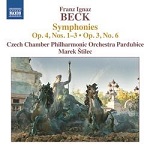 Naxos
have done sterling service for the 18th-century symphony:
this new recording joins earlier albums of Beck’s works – Op.1/1-6 (8.554071:
New Zealand CO/Donald Armstrong – review – review),
Op.3/1-3 (8.570799: Toronto CO/Kevin Mallon – review).
Though three different orchestras have been involved, unlike the only
rival recording from CPO, performed by La Stagione Frankfurt/Michael
Schneider: Op.3/1-6 and Op.4 on three CDs (7778802, also available
separately), the standard of performance is as high on this third album
as its predecessors. Taken together, they help us see where Haydn was
coming from in the work of his Mannheim precursors.
Naxos
have done sterling service for the 18th-century symphony:
this new recording joins earlier albums of Beck’s works – Op.1/1-6 (8.554071:
New Zealand CO/Donald Armstrong – review – review),
Op.3/1-3 (8.570799: Toronto CO/Kevin Mallon – review).
Though three different orchestras have been involved, unlike the only
rival recording from CPO, performed by La Stagione Frankfurt/Michael
Schneider: Op.3/1-6 and Op.4 on three CDs (7778802, also available
separately), the standard of performance is as high on this third album
as its predecessors. Taken together, they help us see where Haydn was
coming from in the work of his Mannheim precursors.
The mp3 supplied by classicsonline.com is fine (£4.99). They also offer
lossless flac for £5.99 but if you must have 24-bit, albeit at something
of a premium ($20.19) you need to turn to eclassical.com. That comes
at a premium even over the cost of the CD equivalent, it does sound
very good.
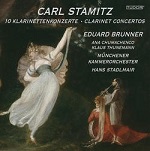 Carl
STAMITZ or STAMIČ (1745-1801) was a member of a Bohemian
family of prolific composers, near-contemporaries of Haydn and Mozart.
Some of his symphonies feature on an attractive Chandos CD in the Contemporaries
of Mozart series (CHAN9358 – from theclassicalshop.net,
mp3 and lossless, or CHAN10628, 5 CDs, budget price, with music
by Krommer, Pleyel, Kozeluch and Wranitzky – from theclassicalshop.net,
mp3 and lossless) but he was also a considerable composer of Clarinet
Concertos. Tudor have released a fine 3-CD set of these and a single-CD
second volume, with Eduard Brunner (clarinet), the Munich Chamber Orchestra
and Hans Stadlmaier (TUDOR1630 [202:49] – download from eclassical.com,
mp3 and lossless, and TUDOR1632 [70:32] – download from eclassical.com,
mp3 and lossless). In some of the works they are joined by Ana Chumachenco
(violin) and Klaus Thunemann (bassoon).
Carl
STAMITZ or STAMIČ (1745-1801) was a member of a Bohemian
family of prolific composers, near-contemporaries of Haydn and Mozart.
Some of his symphonies feature on an attractive Chandos CD in the Contemporaries
of Mozart series (CHAN9358 – from theclassicalshop.net,
mp3 and lossless, or CHAN10628, 5 CDs, budget price, with music
by Krommer, Pleyel, Kozeluch and Wranitzky – from theclassicalshop.net,
mp3 and lossless) but he was also a considerable composer of Clarinet
Concertos. Tudor have released a fine 3-CD set of these and a single-CD
second volume, with Eduard Brunner (clarinet), the Munich Chamber Orchestra
and Hans Stadlmaier (TUDOR1630 [202:49] – download from eclassical.com,
mp3 and lossless, and TUDOR1632 [70:32] – download from eclassical.com,
mp3 and lossless). In some of the works they are joined by Ana Chumachenco
(violin) and Klaus Thunemann (bassoon).
If three or four CDs looks like a daunting prospect, there are fine
single-disc selections of these concertos from Kálmán Berkes and the
Esterházy Sinfonia on Naxos: 8.553584 and 8.554339 – review.
Wolfgang Amadeus MOZART (1756-1791)
String Quintet in g minor, K516
Léner Quartet with L. D’Oliveira (viola)
rec. 1930. ADD/mono
BEULAH EXTRA 1-4BX228 [29:52] – from eavb.co.uk (mp3)
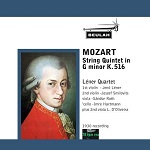 The
Léner Quartet were already well established by 1930 as the Mozart
chamber music performers of their day, so it’s hardly surprising to
read in the November 1930 review of this Columbia recording of their
‘exquisite art’. That recording came on four 78s (LX61-4) and, at 26/-,
cost the equivalent of around £50 today. The four tracks from Beulah
can be yours for a fraction of that: £3.00.
The
Léner Quartet were already well established by 1930 as the Mozart
chamber music performers of their day, so it’s hardly surprising to
read in the November 1930 review of this Columbia recording of their
‘exquisite art’. That recording came on four 78s (LX61-4) and, at 26/-,
cost the equivalent of around £50 today. The four tracks from Beulah
can be yours for a fraction of that: £3.00.
The recording sounds its date: though the surface hiss and crackle has
been kept to a bare minimum, it’s still apparent. This is not one of
those cases where Beulah have been able to magic 78s sound into what
you might expect from a 1950s mono LP, but the performances were well
worth preserving. The style is of its time: not a Meissen-figurine
Mozart but lacking some of the muscle of the Italian Quartet with Arthur
Grumiaux (Philips Duo 4560582, download only), my library choice
in its earlier incarnation in the complete Mozart Edition, or the Grumiaux
Trio-plus on a budget-price Philips 3-CD set 4709502. Nor is
it quite of the same calibre as the Léner recording of the Clarinet
Quintet with Leon Goossens, from which I got to know the music and still
available on Testament SBT1130.
Beulah’s own Korean-released transfers of the Griller Quartet’s 1958
stereo recordings of the Quintets K406, K515 and K516 are more recommendable: 1BX269 – from kr.eavb.co.uk.
Joseph Martin KRAUS (1756–1792) Arias and Overtures
Overture: Proserpin, VB19 [8:19]
Du i hvars oskuldsfulla blick, VB30*† [2:02]
Ma tu tremi, VB63*† [3:17]
Ch’io mai vi possa, VB59*† [4:03]
Overture: Zum Geburtstage des Königs Gustav III, VB41 [8:54]
Parvum quando cerno Deum, VB5*† [7:43]
Overture: Äfventyraren, VB32* [10:30]
Du temps, qui détruit tout, VB58† [2:25]
Sentimi, non partir! – Al mio bene, VB55† [7:05]
Overture: Konung Gustav III Begrafnings-kantat, VB42 [6:20]
Hör mina ömma suckar klaga, VB26*† [1:45]
†Monica Groop (mezzo)
Helsinki Baroque Orchestra/Aapo Häkkinen
rec. Sello Hall, Espoo, Finland, 10–12 June 2013. DDD
*world première recording
pdf booklet included: texts and translations also available online.
NAXOS 8.572865 [62:47] – from classicsonline.com (mp3 and lossless) or stream from Naxos
Music Library
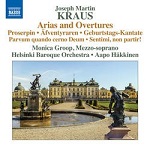 I
first got to know the music of Kraus from a Nonesuch LP entitled ‘Music
for Kings’: one of his symphonies in c minor with music by Gaetano Brunetti
(H71156). Though he was born near Mainz, the king in question was Gustav
III of Sweden, with whose court he became closely associated: one of
the works here is for Gustav’s birthday and another the overture to
a funeral cantata for him. Kraus’s music is not much better known now
than when that LP was released in 1968. Though there are more recordings
on offer, many of them on Naxos, the majority of this new album consists
of first recordings and the music really is as good as all but the best
of Haydn – who admired it – and Mozart, whose equal Haydn judged Kraus
to be.
I
first got to know the music of Kraus from a Nonesuch LP entitled ‘Music
for Kings’: one of his symphonies in c minor with music by Gaetano Brunetti
(H71156). Though he was born near Mainz, the king in question was Gustav
III of Sweden, with whose court he became closely associated: one of
the works here is for Gustav’s birthday and another the overture to
a funeral cantata for him. Kraus’s music is not much better known now
than when that LP was released in 1968. Though there are more recordings
on offer, many of them on Naxos, the majority of this new album consists
of first recordings and the music really is as good as all but the best
of Haydn – who admired it – and Mozart, whose equal Haydn judged Kraus
to be.
Though nothing here is as substantial as Kraus’s symphonies, it’s a
very attractive collection, performed and recorded with style. The
quality of the two overtures here for Gustav and the Naxos recording
of the orchestral excerpts from the opera Æneas in Carthage,
which I also enjoyed hearing – review and review – makes me wish that we had more complete recordings of his longer
works.
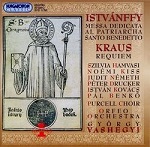
That wish is partly gratified by a Hungaroton recording of his Requiem,
coupled with Benedek ISTVÁNFFY’s (1733-1778) Mass for
St Benedict (HCD31782: Judit Németh and other soloists; Purcell
Choir; Orfeo Orchestra/György Vashegyi – rec. c.1997?). Download from eclassical.com (mp3 and lossless, no booklet) or stream from Naxos
Music Library. Fine music – Istvánffy deserves to be better known
almost as much as Kraus – well performed and recorded. With the text
of the Mass and Requiem easily available, the lack of the booklet
is, for once, no great matter, though I would have liked to know more
about Istvánffy, the Hungarian Wikipedia
article, not being a great deal of use to non-speakers of that most
difficult language.
Recording of the Month
 Ludwig
van BEETHOVEN (1770-1827)
Ludwig
van BEETHOVEN (1770-1827)
Piano Concerto No. 3 [38:16]
Piano Concerto No. 4 [35:01]
Maria João Pires (piano)
Swedish Radio Symphony Orchestra/Daniel Harding
rec. Berwaldhalle, Stockholm, 9-11 October 2013. DDD
No booklet. (Available for subscribers from Naxos
Music Library)
ONYX 4125 [71:30] – from eclassical.com (mp3 and lossless) or stream from Naxos
Music Library
‘[T]his disc contains many pleasures and will certainly
be warmly welcomed by the many admirers of Maria João Pires.’ See review by John Quinn.
‘This disc was both exhilarating and enlightening to listen to. Let’s
hope there is more on the way.’ See review by Simon Thompson.
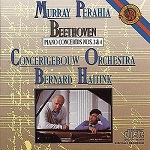
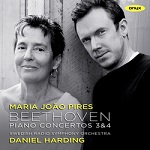 Last
time round I was extolling the virtues of the classic performances of
these two concertos by Schnabel and Sargent, finally discovered courtesy
of Naxos Historical 50 years after I dropped and broke the 78s of the
Third. That apart, my benchmark for these works remains Stephen Kovacevich
– then known as Stephen Bishop – and Colin Davis (Eloquence 4-CDs 4805946,
Piano Concertos, Violin Concerto and Triple Concerto, or Decca 4786452,
6 CDs: Piano Concertos, Diabelli Variations and 8 Sonatas) and, more
recently, Howard Shelley’s complete recording for Chandos.
Last
time round I was extolling the virtues of the classic performances of
these two concertos by Schnabel and Sargent, finally discovered courtesy
of Naxos Historical 50 years after I dropped and broke the 78s of the
Third. That apart, my benchmark for these works remains Stephen Kovacevich
– then known as Stephen Bishop – and Colin Davis (Eloquence 4-CDs 4805946,
Piano Concertos, Violin Concerto and Triple Concerto, or Decca 4786452,
6 CDs: Piano Concertos, Diabelli Variations and 8 Sonatas) and, more
recently, Howard Shelley’s complete recording for Chandos.
The Kovacevich is listed among the recent MusicWeb International Recommends,
but I see that most votes were cast for Murray Perahia with the Concertgebouw
and Bernard Haitink, so I took the opportunity of getting to know that
recording too (Sony, with Concerto No.4 – download from 7digital.com, mp3, or stream from Naxos
Music Library or Qobuz.
Available on CD only as part of 3-CD set 88697102902).
Other recordings of these concertos worth investigating include:
• NAXOS CLASSICAL ARCHIVES 9.80076/78: Nos.1-5: Wilhelm
Kempff/Paul van Kempen. Having been nurtured on Kempff’s later stereo
recordings with Ferdinand Leitner, I tried this earlier mono set from
1952/3 – from emusic.com or classicsonline.com,
both mp3. Not available in the USA and several other countries, but
the alternative on DG 4357442 should be. The performances are,
if anything, even better than the later versions and the recordings
sound decent for their age, if you keep the volume down to avoid mild
distortion. The lossless version streamed from Qobuz sounds better than the low bit-rate mp3 from emusic.com, so you may
prefer to buy it there for £7.19. See review and review of earlier Rosette series release.
• BIS-SACD-1692, 1693, 1792, 1793 : Nos. 1-5: Ronald Brautigam/Andrew
Parrott – 2014/7
• EMI 5009272: Nos.1-5; Triple Concerto: Christian Zacharias/Hans
Vonk. A very fine 3-CD bargain set – review.
Now available only as a download: most economically obtained from sainsburysentertainment.co.uk (320 kb/s mp3)
• DECCA 4578449: Nos. 1-5; Choral Fantasia and Diabelli
Variations: Julius Katchen/Pierino Gamba – November
2010. Now download only – ignore defunct passionato.com link: prestoclassical.co.uk have it in mp3 and lossless. Stream from Qobuz.
• ICA ICAC5107: Nos.1 and 3: Ingrid Jacoby/Jacek
Kaspszyk – 2013/16
• NAIVE V5347: No.3, Op.111 and ‘Moonlight’
Sonatas: Fazil Say/Gianandrea Noseda – review.
Download from eclassical.com (mp3 and lossless)
• ALPHA122: No.3 and No. ‘6’: Arthur Schoonderwoerd
(fortepiano and conductor). Now also available as a complete set of
concertos 1-‘6’: one chiefly for authenticists.
• BEULAH 1PD99: No.4: Rubinstein (+ Chopin, Franck)
– 2014/11
• ALPHA079: Nos. 4 and 5: Arthur Schoonderwoerd
(fortepiano and conductor) – December
2010 – for those seeking a lighter approach (see above, 3 and ‘6’)
• BIS-SACD-1758: Nos. 4 and 5: Yevgeny Sudbin/Osmo
Vänskä
• REGIS RRC1627: Emil Gilels/Leopold Ludwig – April
2011/1
Both Pires and Perahia deserve to stand at or very near to the top of
a distinguished list. I shall not abandon Kovacevich but they will
join him in my listening to these concertos. Both sound well even in
mp3, the Onyx better still in lossless sound – and remember that mp3
and lossless come at the same price from eclassical.com.
Ludwig van BEETHOVEN (1770-1827) Violin Sonatas No.2 and
No.4*, 12 Variations on Mozart’s Se vuol ballare* and Piano Trios
No.3 and No.5 (‘Ghost)**
Johann Nepomuk HUMMEL (1778-1837) Piano Trio No.4**
Daniel Sepec (violin), Andreas Staier (period pianoforte), Jean-Guihen
Queyras (cello)
HM Gold HMG508398.99 [2:05:08] – from eclassical.com (mp3 and lossless) or stream from Naxos
Music Library or Qobuz
* from HMC901919. **from HMC901955, released 2008.
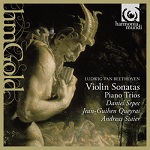
Though these recordings are reissued at mid price – as little as £7.87
from one dealer currently, reduced from £11.25 – eclassical.com’s per-second
pricing policy, which usually works to the buyer’s advantage, means
that the download costs significantly more ($22.52). Even for buyers
in US dollars that’s slightly more than amazon.com’s $19.05 for the
CDs. The lack of a booklet is also a disincentive. (NML and Qobuz
don’t offer one, either.)
That said, there’s a lot to like about this reissue. The Violin Sonatas
– played on a period fortepiano and a restored violin presented to Beethoven
– are enjoyably and refreshingly lively. The Piano Trios also receive
attractively fresh performances and the inclusion of the Hummel is an
added incentive.
Johannes BRAHMS (1833-1897)
Symphony No.3 in F, Op.90 (1883) [38:06]
Symphony No.4 in e minor, Op.98 (1884) [38:09]
London Symphony Orchestra/Valery Gergiev
rec. Barbican, London, December 2013. DDD/DSD
pdf booklet included
LSO LIVE LSO0737 [77:15] – from hyperion-records.co.uk (mp3, 16- and 24-bit lossless)
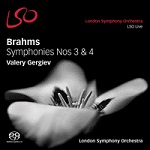 Volume
1, containing symphonies 1 and 2, didn’t sit too well with most reviewers,
including our own Simon
Thompson, for whom – and others –memories of Gergiev with the LSO
at Edinburgh in 2012 were not fulfilled by their later Barbican performances.
Volume
1, containing symphonies 1 and 2, didn’t sit too well with most reviewers,
including our own Simon
Thompson, for whom – and others –memories of Gergiev with the LSO
at Edinburgh in 2012 were not fulfilled by their later Barbican performances.
Whatever else you may think of the concluding volume, it certainly offers
excellent value – I don’t recall any other recording which couples these
two symphonies, except in complete sets, but, with almost 200 CDs of
the Fourth in the current catalogue, I’m not going to check. That’s
about the best that I can say, however. I expected Gergiev to out-Klemperer
Klemperer and knock me out of my seat at the start of the Third but
I have to rule him out as too genteel, perhaps in part because of the
Barbican acoustic, though that usually troubles me less than other reviewers.
After that start, I failed to engage with this performance.
The contest used to be between Otto Klemperer and Bruno Walter but despite
my continuing preference for the former, Walter too injects much more
life into this movement right from the start than Gergiev. The recently
released 5-CD set Bruno Walter conducts Brahms (Sony 88843072592:
£8.99 from sainsburysentertainment.co.uk or stream from Qobuz)
makes a fine adjunct to the Klemperer set of the symphonies, overtures
and Deutsches Requiem which EMI reissued some time ago (4043382,
4CDs).
Gergiev’s Fourth opens more auspiciously, though he allows the tempo
drag in the middle of the first movement. More seriously, I was still
disappointed with the slightly muffled sound quality – I’m sure it’s
not the fault of the 24-bit download. I even checked to see that my
DAC was at the correct setting. When reviewers played the first CDs
they spoke of a veil being lifted between the recording and listener.
Here it’s as if that veil has descended again, though a slight volume
boost helps.
It’s a shame that I couldn’t warm to Gergiev’s Third and that the recording
throughout is less than ideal – Walter streamed in lossless format from
Qobuz actually sounds better – because I enjoyed this version of the
Fourth, not an easy work to bring off, especially the finale. My overall
recommendation remains with Klemperer or Riccardo Chailly’s set of the
symphonies (Decca 4787471 – lower price reissue – or 4785344:Recording
of the Month – review and 2014/1:
also on blu-ray 4787696).
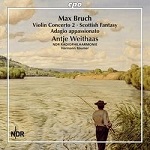 Max
BRUCH (1838-1920). Last month I reviewed a new recording of the Scottish Fantasy, Op.46, coupled with his Violin Concerto No.3
on Hyperion. Almost simultaneously another recording of the Fantasy
has appeared on CPO, coupled this time with Violin Concerto No.2,
Op.44 and Adagio Appassionato, Op.57: Antje Weithaas
(violin) with Hannover NDR Philharmonie/Hermann Bäumer. (777833-2 [69:54] – from eclassical.com,
mp3 and lossless, with pdf booklet). This is listed as Volume 1 of
a planned series of Bruch’s complete works for violin and orchestra:
wisely CPO have decided not to plunge in first into the hotly contested
area of Violin Concerto No.1.
Max
BRUCH (1838-1920). Last month I reviewed a new recording of the Scottish Fantasy, Op.46, coupled with his Violin Concerto No.3
on Hyperion. Almost simultaneously another recording of the Fantasy
has appeared on CPO, coupled this time with Violin Concerto No.2,
Op.44 and Adagio Appassionato, Op.57: Antje Weithaas
(violin) with Hannover NDR Philharmonie/Hermann Bäumer. (777833-2 [69:54] – from eclassical.com,
mp3 and lossless, with pdf booklet). This is listed as Volume 1 of
a planned series of Bruch’s complete works for violin and orchestra:
wisely CPO have decided not to plunge in first into the hotly contested
area of Violin Concerto No.1.
The Second Concerto is well worth hearing – like Tchaikovsky’s Second
Piano Concerto it has languished too long in the shadow of its predecessor
– and it receives a performance which ought to make it more popular.
I said that CPO had avoided an area hotly contested, but there are several
very fine performances of the Scottish Fantasy, a work deservedly
almost as popular as Violin Concerto No.1: Oistrakh and Horenstein (mid-price
Decca Legends), Liebeck and Brabbins (Hyperion – 2014/12),
Chung and Kempe (budget Decca Virtuoso) and Benedetti and Macdonald
(Decca – 2014/9).
The new recording is one of only two to couple it with the Second Concerto
– the other is from Accardo and Masur in the complete concertante works,
a fine bargain on Double Decca. The performance and recording of both
works on CPO are such as to make it a safe purchase if that’s the combination
that you are looking for.
Second Thoughts.
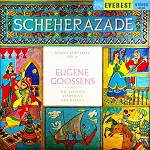 When
I reviewed two recordings of Nikolai RIMSKY KORSAKOV (1844-1908) Scheherazaderecently, I didn’t mention the Everest reissue
of the vintage recording made by Eugene Goossens with the LSO in 1958
(SDBR3026), though I had reviewed it along with several other
Everest releases late last year – see 2013/15 – and it’s also caught the attention of several of my colleagues – review – review and Listening
Studio. Having almost damned it with faint praise then, I decided
to listen again and decided that I’d been rather harsh. This time the
performance held me throughout, though memories of Beecham’s recording
of a similar vintage, or of the live performance which I heard Sir Charles
Groves give with the RLPO many years ago, were still not dispelled.
The recording shows its age less than the Beecham – even heard on headphones
there is almost no background noise. The individual strands are pinpointed
while remaining integrated in the overall sound picture. The iTunes download is the one most easily obtained in the UK – mp4 at around 290kb/s:
if you need mp3 you have to use a conversion programme.
When
I reviewed two recordings of Nikolai RIMSKY KORSAKOV (1844-1908) Scheherazaderecently, I didn’t mention the Everest reissue
of the vintage recording made by Eugene Goossens with the LSO in 1958
(SDBR3026), though I had reviewed it along with several other
Everest releases late last year – see 2013/15 – and it’s also caught the attention of several of my colleagues – review – review and Listening
Studio. Having almost damned it with faint praise then, I decided
to listen again and decided that I’d been rather harsh. This time the
performance held me throughout, though memories of Beecham’s recording
of a similar vintage, or of the live performance which I heard Sir Charles
Groves give with the RLPO many years ago, were still not dispelled.
The recording shows its age less than the Beecham – even heard on headphones
there is almost no background noise. The individual strands are pinpointed
while remaining integrated in the overall sound picture. The iTunes download is the one most easily obtained in the UK – mp4 at around 290kb/s:
if you need mp3 you have to use a conversion programme.
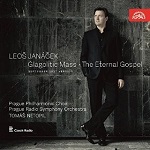
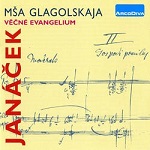 Leoš
JANÁČEK (1854–1928) My Desert Island work by Janácek
would have to be the Glagolitic Mass. Hitherto my favourite
recordings have been from Karel Ančerl, the recording on
which I first heard the work (Supraphon SU36672, with Taras
Bulba – review), Antoni Wit (Naxos 8.572639 with Sinfonietta – December
2011/1) and Sir Charles Mackerras (Chandos CHAN9310,
with Kodály Psalmus Hungaricus – also December
2011/1). The Ančerl is also available from Beulah: 1PD66 –2013/16:
stream from Qobuz.
Leoš
JANÁČEK (1854–1928) My Desert Island work by Janácek
would have to be the Glagolitic Mass. Hitherto my favourite
recordings have been from Karel Ančerl, the recording on
which I first heard the work (Supraphon SU36672, with Taras
Bulba – review), Antoni Wit (Naxos 8.572639 with Sinfonietta – December
2011/1) and Sir Charles Mackerras (Chandos CHAN9310,
with Kodály Psalmus Hungaricus – also December
2011/1). The Ančerl is also available from Beulah: 1PD66 –2013/16:
stream from Qobuz.
The Mackerras is described as the original version, but recent research
has cast doubts on that attribution and a new recording has recently
appeared which claims to be the true original: (Prague Philharmonic
Choir, Prague Radio SO/Tomáš Netopil: Supraphon SU40512 – from emusic.com, mp3, no booklet). Alongside that new recording I
have been listening to the final version on an ArcoDiva recording, coupled,
like the new Supraphon, with The Eternal Gospel (Czech Philharmonic
Choir, Czech Symphony Orchestra, Brno/Leos Svarovsky: UP0011-2231 –
review – from
eclassical.com, mp3 and lossless, no booklet. Stream fromQobuz.
CD £12 from MusicWeb
International).
I have to admit that I didn’t notice too many differences between the
Netopil and the Mackerras recordings or, to be honest, between either
of these ‘original’ versions and the final masterpiece. It’s a very
powerful work in either form and all concerned on the new Supraphon
do it full justice. I didn’t know The Eternal Gospel, but this
performance has ‘sold’ it to me. The emusic.com download weighs in
at about 225kb/s – far from ideal, but it sounds well enough, with a
little volume boost, and it’s almost as good as you are likely to get
by paying more from Amazon and iTunes.
The ArcoDiva comes in lossless sound and, though older than the Netopil,
sounds excellent. Marc Bridle thought very highly of the performances
– see link above – and I, too, was most impressed. There’s plenty of
power in all the recordings that I have mentioned. Fans of the original
can safely choose between Mackerras and the more authentic Netopil,
while those who favour the final version can choose between Ančerl,
Wit and Svarovsky on the basis of coupling and/or price.
The lack of booklet with either of these downloads is a serious problem
– Old Slavonic liturgical texts are not exactly common knowledge – but
Chandos generously offer theirs free to all comers.
Gustav MAHLER (1860-1911)
Das Lied von der Erde (1908)
Christa Ludwig (alto), Waldemar Kmentt (tenor)
Vienna Symphony Orchestra/Carlos Kleiber
rec. live 1967. ADD
pdf booklet included
WIENER SYMPHONIKER WS007 [58:33] – from eclassical.com (mp3 and lossless)
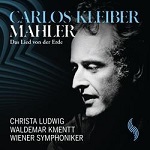 The
Carlos Kleiber Lied von der Erde has gained a reputation for
being un-listenable, the recording engineers having apparently set up
their equipment and left it on auto-pilot. The new attempt to patch
things up starts most unpromisingly, with blasting on the opening notes,
but soon settles down to being just tolerable.
The
Carlos Kleiber Lied von der Erde has gained a reputation for
being un-listenable, the recording engineers having apparently set up
their equipment and left it on auto-pilot. The new attempt to patch
things up starts most unpromisingly, with blasting on the opening notes,
but soon settles down to being just tolerable.
The performance – one of the few occasions when Kleiber conducted Mahler,
possibly the only one – is certainly worth preserving in its best possible
form. Christa Ludwig made many recordings of the work, all of them
treasurable, and her singing is the main reason to hear this live recording.
Waldemar Kmentt’s contribution is slightly less treasurable, but that
may be because the recording overloads at his loudest passages, making
him sound ‘shouty’ in the opening movement. Matters have improved when
he reappears in the third movement – perhaps the engineers had come
back from their break and tweaked the controls?
Not the sole recording for your library, then, but well worth hearing.
Among the many alternatives eclassical.com alone have several better
performances but my own favourite remains Janet Baker and James King
with the Concertgebouw Orchestra and Bernard Haitink (Eloquence 4681822,
also available as a Classic FM Full Works download from 7digital.com for £4.99 and on a 2-CD set, with Symphony No.9, from 7digital.com for £7.49). The Berlin Classics version conducted by
Kurt Sanderling, which Tony Duggan placed top of his list –article – can be streamed from Qobuz and purchased there in lossless sound for £6.49. I hadn’t heard it
before but it’s certainly a strong contender.
Claude DEBUSSY (1862–1918)
Images, Book I, L105 (1905) [15:55]
Images, Book II, L120 (1907) [14:52]
Préludes, Book II, L131 (1913) [39:47]
Marc-André Hamelin (piano)
rec. Henry Wood Hall, London, 22 April 2011 (Préludes) and 25
August 2012 (Images)
pdf booklet included
HYPERION CDA67920 [70:35] – from hyperion-records.co.uk (mp3, 16- and 24-bit lossless)
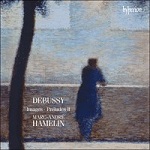 Having
recently reviewed Marc-André Hamelin’s superb performances of Janácek
and Schumann on Hyperion, I am pleased to report that this new recording
of music by Debussy is of similar high quality. I like the programme:
to have both sets of Images together with a complete performance
of Préludes Book 2 is a real treat.
Having
recently reviewed Marc-André Hamelin’s superb performances of Janácek
and Schumann on Hyperion, I am pleased to report that this new recording
of music by Debussy is of similar high quality. I like the programme:
to have both sets of Images together with a complete performance
of Préludes Book 2 is a real treat.
Right from the outset of Images, in Reflets dans l’eau,
Hamelin clearly shows his understanding of Debussy’s style, with subtle rubato, delicacy of touch and gently rippling cascades of fast
notes. In Hommage à Rameau the rubato is also very convincing
and the textures are well conceived. In the loud chordal passages, the
melody line always sings above. Mouvement is given a scintillating
performance and Hamelin copes brilliantly with the virtuosic demands
here. He certainly plays with a ‘fantastic but precise lightness’ as
specified by Debussy.
I still have a slight preference for my benchmark performance by Arturo
Benedetti Michelangeli in these works (DG Originals). In Book 1 for
example, Hamelin’s slower tempo in Hommage à Rameau takes a bit
of getting used to. Michelangeli’s Mouvement has greater clarity
in the opening triplet semiquavers. However, the recording shows its
age and sounds a bit dry, so I would certainly recommend the Hyperion
for listeners new to Images and indeed for all lovers of Debussy.
Cloches à travers les feuilles in Book 2 demonstrates
Hamelin’s delicacy of touch. It is marked to be played softly for almost
its entirety, but Hamelin produces a huge range of colour within the
overall softness and, as in the ensuing piece, he provides real clarity
in the balance of the parts. His is a more romantic performance of Et
la lune descende sur le temple qui fut than the more austere and
classical approach of Michelangeli who is very precise in his adherence
to dynamic markings and he makes very clear distinctions between Debussy’s
markings for ‘soft’ and ‘very soft’. Hamelin, however, is most convincing
and his playing is very attractive indeed.
Finally in this set, Poissons d’or is an evocative description
of the imagined movements of two carp on the Japanese lacquered plaques
in the composer’s study. There is a fine balance of textures and colours
combined with virtuosic delicacy here. I prefer Hamelin to Michelangeli
who presents us with a rather bumpy start, certainly not ‘very soft
and as light as possible’ as marked by Debussy. Hamelin changes the
mood at Capricieux et souple playing with a sense of wit. He
captures the humour here before the drama and virtuosity which follow
and bring the work to its gentle conclusion.
The recording proceeds with Preludes Book 2. In Brouillards the melody sings above a hazy background which Hamelin keeps very
soft so that the mist never becomes too foggy. He always maintains a
sense of flow and this is maybe helped by his slightly heavy opening
chord. Jean-Pierre Armengaud on ARTS Music sounds comparatively stodgy
here. Feuilles mortes needs real clarity of pedalling and this
is achieved by Hamelin in this predominantly chordal piece. In La
puerta del Vino he plays with an infinite variety
of touch and colour with glaring contrasts between the passages which
Debussy asks to be played ‘with violence’ and those of a more romantic
nature. A fabulous performance in which the passionate moods and feeling
of the Habanera are well captured by Hamelin. He is more effective
than most others I have heard, for example Yukie Nagai on BIS who seems
to want to push the music forward too quickly.
Bruyères is full of evocative colours in perfect harmony, but
perhaps Hamelin is a touch too loud and excitable for the calm mood
indicated by Debussy. Nagai is a little slower and less vigorous and
this pianist gets nearer to the heart of the piece than Hamelin. Walter
Gieseking is perfect in this Prelude, and his great recording of Debussy
Preludes (EMI Classics) should be in everyone’s collection. La terrasse
des audiences du clair de lune begins with some very
sensitive and delicate playing, and the piece is characterised by subtle rubato. The chords are perfectly balanced at the start of Canope whilst the contrasting Les tierces alternées displays Hamelin’s
virtuosity in the delicate fast semiquavers. The pyrotechnics of Feux d’artifice are managed with consummate ease by our pianist.
Debussy’s music is clearly in Hamelin’s blood and he understands perfectly
its beguiling intimacy. There are already several fine recorded performances
of these Preludes, especially from Gieseking but also from Pascal Rogé
on Onyx. Nevertheless, Hamelin’s deeply personal accounts of Images and the Préludes Book 2 are very rewarding. As ever, the quality
of Hyperion’s recording – and documentation (BW) – is
excellent.
Geoffrey Molyneux
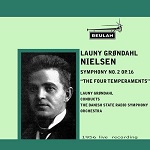 Reissue
of the Month
Reissue
of the Month
 Mention
recordings of the symphonies of Carl NIELSEN (1865-1931) from
the 1950s and the names Jensen and Tuxen spring to mind. You may not
even have heard of Launy Grøndahl, whose live 1956 recording of Symphony
No.2, The Four Temperaments, with the Danish State Radio Orchestra
has been released by Beulah (1-4BX294 – from eavb.co.uk).
If you don’t wish to invest in the Danacord set of all six symphonies
which included it (DACOCD351-3) which, in any case, seems to be out
of stock at the moment, this is your chance. That set was the worthy
winner of a Historical Recording award in 1985 and this is one of the
best of the recordings in it. The sound is not ideal but more than tolerable
– no more dated than mono LPs of this vintage.
Mention
recordings of the symphonies of Carl NIELSEN (1865-1931) from
the 1950s and the names Jensen and Tuxen spring to mind. You may not
even have heard of Launy Grøndahl, whose live 1956 recording of Symphony
No.2, The Four Temperaments, with the Danish State Radio Orchestra
has been released by Beulah (1-4BX294 – from eavb.co.uk).
If you don’t wish to invest in the Danacord set of all six symphonies
which included it (DACOCD351-3) which, in any case, seems to be out
of stock at the moment, this is your chance. That set was the worthy
winner of a Historical Recording award in 1985 and this is one of the
best of the recordings in it. The sound is not ideal but more than tolerable
– no more dated than mono LPs of this vintage.
Bargain of the Month

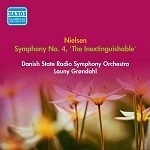 Beulah
have already released Thomas Jensen’s 1952 live recording of the Fourth
Symphony, The Inextinguishable, on 1BX161. Naxos Classical
Archives have a transfer of Grøndahl’s 1951 recording of The Inextinguishable,
again with the Danish Radio Orchestra (9.80540). It can be yours
for just £0.84 from emusic.com or for £1.99 from classicsonline.com, provided that you don’t live in
the USA or anywhere else where it’s still copyright. If you want it
in lossless sound, that will cost you a little more from eclassical.com ($6.56). The sound is no better than you would expect for the period
– it was first released on 78s (DB20156-60) before being issued on LP
in 1952 and it was thought to be not ideal even then. The transfer sounds
a little shrill but this, too, was a performance well worth being resurrected.
See Gerald Fenech’s review of the Dutton reissue – his first choice – which is no longer available:
one hopeful is currently asking £47.95 for it. Even that is less than
the equivalent of what those 78s cost – over £50 in modern terms – so
this reissue is really good value.
Beulah
have already released Thomas Jensen’s 1952 live recording of the Fourth
Symphony, The Inextinguishable, on 1BX161. Naxos Classical
Archives have a transfer of Grøndahl’s 1951 recording of The Inextinguishable,
again with the Danish Radio Orchestra (9.80540). It can be yours
for just £0.84 from emusic.com or for £1.99 from classicsonline.com, provided that you don’t live in
the USA or anywhere else where it’s still copyright. If you want it
in lossless sound, that will cost you a little more from eclassical.com ($6.56). The sound is no better than you would expect for the period
– it was first released on 78s (DB20156-60) before being issued on LP
in 1952 and it was thought to be not ideal even then. The transfer sounds
a little shrill but this, too, was a performance well worth being resurrected.
See Gerald Fenech’s review of the Dutton reissue – his first choice – which is no longer available:
one hopeful is currently asking £47.95 for it. Even that is less than
the equivalent of what those 78s cost – over £50 in modern terms – so
this reissue is really good value.
Ralph VAUGHAN WILLIAMS (1872-1958)
Concerto Grosso for String Orchestra [16:54]
Concerto for Oboe and Strings in a minor [19:57]
Concerto for Violin and String Orchestra in d minor * [16:49]
Concerto for Bass Tuba and Orchestra in F minor [13:12]
Two Hymn-Tune Preludes [8:19]
The Lark Ascending ** [15:27]
Piano Concerto in C [25:42]
Partita for Double String Orchestra [19:43]
Toward the Unknown Region [13:19]
David Theodore (oboe)
Patrick Harrild (tuba)
Kenneth Sillito (violin) *
Michael Davis (violin) **
Howard Shelley (piano)
London Symphony Chorus
London Symphony Orchestra/Bryden Thomson
rec. 1987-1990. DDD
pdf booklet included
CHANDOS CHAN9262-3 [148:48] – from theclassicalshop.net (mp3 and lossless)
Symphony No. 4 in f minor [33:24]
Concerto for Violin and String Orchestra in d minor [16:49]
Kenneth Sillito (violin)
London Symphony Orchestra/Bryden Thomson
rec. November 1987 (Symphony) and March 1988 (Concerto). DDD
pdf booklet included
CHANDOS CHAN8633 [50:25] – from theclassicalshop.net (mp3 and lossless)
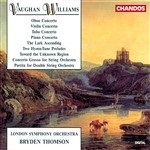
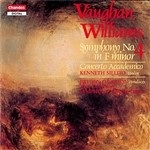 The
recent release of a new recording of the Violin Concerto (Tamsin Waley-Cohen,
Signum, 2014/12)
prompted me to point to the existence of the earlier Kenneth Sillito
recording, available with the complete concertos or with the Fourth
Symphony. You may have wondered why I referred to ‘the alternative Chandos
couplings’ without further details. I’d actually intended to refer to
it but had to cut it out at the last minute for lack of time, leaving
a meaningless comment.
The
recent release of a new recording of the Violin Concerto (Tamsin Waley-Cohen,
Signum, 2014/12)
prompted me to point to the existence of the earlier Kenneth Sillito
recording, available with the complete concertos or with the Fourth
Symphony. You may have wondered why I referred to ‘the alternative Chandos
couplings’ without further details. I’d actually intended to refer to
it but had to cut it out at the last minute for lack of time, leaving
a meaningless comment.
The fact that both couplings remain at full price is the only possible
reason for any reservation, now that my favourite recording from James
Buswell, part of RCA’s series of VW releases with André Previn and the
LSO is unavailable except as a download of the complete set of the symphonies
(£24.99 from sainsburysentertainment.co.uk). It is possible to buy the three
tracks of the concerto separately for £0.99 each.
Ralph VAUGHAN WILLIAMS (1872-1958)
Symphony No. 5 in D [43:37]
Symphony No. 7, ‘Sinfonia antartica’ [42:06]
Sheila Armstrong, Ladies of the London Philharmonic Choir
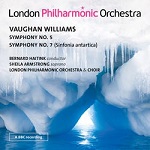 London
Philharmonic Orchestra/Bernard Haitink
London
Philharmonic Orchestra/Bernard Haitink
LONDON PHILHARMONIC ORCHESTRA LPO0072 [85:43] – from eclassical.com (mp3 and lossless)
Dan Morgan liked this recording of the Fifth better than the Seventh
– review.
I’ve been a while catching up with this recording because at first I
didn’t see the point of trying this 2-CD set when I already have the
Haitink complete set of VW symphonies (EMI), but now that I have I can
see that the live recording adds an extra something even to those very
fine performances. I suspect that Dan’s views on the Seventh were partly
motivated by the feeling that this is a work of less inspiration than
the Fifth whereas I rate it higher. Scott of the Antarctic was
the first film which made a big impact on me, aged seven, music included,
so I’m very happy to praise both halves of this very welcome offering.
Manuel De FALLA (1876-1946)
Noches en los jardines de España [25:52]
El sombrero de tres picos – three dances [3:20 + 3:57 + 2:57]
Fantasia Bética [13:05]
El amor brujo (piano suite) [16:41]
Luis Fernando Pérez (piano); Basque National Orchestra/Carlo Rizzi
rec. Auditorium de Bordeaux 11-12 April 2013 and Aula de Música de Alcalá
de Henares 15-17 June 2013. DDD
pdf booklet included
MIRARE MIR219 [65:48] – from eclassical.com (mp3, 16- and 24-bit lossless)
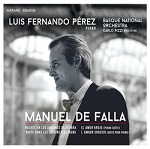
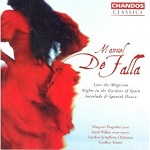 Luis
Pérez is advertised as ‘the only Spanish pianist since Alicia de Larrocha
to have championed his native repertory with such passion.’ That’s a
pretty strong claim, given that Larrocha’s repertoire is currently being
revived on the Australian Eloquence label. Her first (1970) recording
of Noches en los jardines de España, with the OSR and Sergiu
Comissiona is on 4807704 and her later recording with Frühbeck
de Burgos is on an inexpensive Double Decca – The essential Falla (4661282) – and it’s that second recording, together with Gonzalo
Soriano/Ataúlfo Argenta, recently reissued by Beulah (2PD88 – 2014/2*)
that forms my benchmark. With those comparisons in mind I was slightly
disappointed by the new recording, which never really gets going properly
– it’s as if the whole work is dominated by the Danza lejana,
or distant dance, of the second movement. Even with the volume a notch
or two higher than usual and even listening to the 24-bit version, I
didn’t hear the advertised passion.
Luis
Pérez is advertised as ‘the only Spanish pianist since Alicia de Larrocha
to have championed his native repertory with such passion.’ That’s a
pretty strong claim, given that Larrocha’s repertoire is currently being
revived on the Australian Eloquence label. Her first (1970) recording
of Noches en los jardines de España, with the OSR and Sergiu
Comissiona is on 4807704 and her later recording with Frühbeck
de Burgos is on an inexpensive Double Decca – The essential Falla (4661282) – and it’s that second recording, together with Gonzalo
Soriano/Ataúlfo Argenta, recently reissued by Beulah (2PD88 – 2014/2*)
that forms my benchmark. With those comparisons in mind I was slightly
disappointed by the new recording, which never really gets going properly
– it’s as if the whole work is dominated by the Danza lejana,
or distant dance, of the second movement. Even with the volume a notch
or two higher than usual and even listening to the 24-bit version, I
didn’t hear the advertised passion.
If you like your Noches to sound delicate and peaceful, this
is the version for you. The inclusion of Fantasia Bética is a
definite plus, but it’s to Larrocha, Soriano or Margaret Fingerhut and
Geoffrey Simon on mid-price Chandos (CHAN10232 – from theclassicalshop.net,
mp3 and lossless) that I shall return. The Chandos comes with
the complete El amor brujo in orchestra form – a recording that
I’ve owned and enjoyed for many years in its brief incarnation when
licensed to Boots in-house label. Any one of these performers brings
me the music that I fell in love with fifty years ago.
The rest of the programme is for solo piano and here the performance
and recording, made in a different venue and at a different date, have
all the punch that I missed in Noches. If these piano pieces
are your priority, this could be for you.
* You’ll also find reviews of two Harmonia Mundi recordings, both with
Josep Pons, of Noches, with El sombrero de tres picos,
Suites 1 and 2 (HMC901606) and with piano works (HMC90299)
in 2014/2.
Sergei PROKOFIEV (1891-1953)
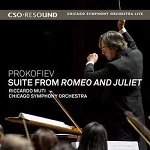
If you want the complete ballet Romeo and Juliet, Op.64,
the clear choice is André Previn’s Warner/EMI budget-price twofer (9677012).
If, however, you are happy with a 48:50 selection from Suites 1 and
2, Op.64a and 64b, Riccardo Muti with the Chicago SO offers just what
you need on CSO Resound CSOR9011402 – download from eclassical.com,
mp3, 16- and 24-bit lossless, with booklet. It was from a similar selection
from the Czech Philharmonic conducted by Karel Ancerl on Supraphon that
I got to know the music: that selection remains available on mid-price SU36762, with Peter and the Wolf, but the CSO recording
offers an equally attractive introduction and a more modern (live) recording,
especially from the 24-bit version.
Muti’s earlier account of this music, with the concert oratorio Ivan
the Terrible, remains available on EMI 0979822 (2 CDs, mid
price).
Dmitry SHOSTAKOVICH (1906-1975)
Symphony No.13 in b-flat minor, ‘Babi Yar’, Op.113 (1962) [59:39]
Alexander Vinogradov (bass)
Men’s Voices of the Royal Liverpool Philharmonic Choir and the Huddersfield
Choral Society
Royal Liverpool Philharmonic Orchestra/Vasily Petrenko
rec. Liverpool Philharmonic Hall, England, 27-29 September 2013. DDD
pdf booklet included
NAXOS 8.573218 [59:39] – from classicsonline.com (mp3) or eclassical.com (mp3, 16- and 24-bit lossless) or stream from Naxos
Music Library or Qobuz
‘This quite outstanding Naxos recording provides tough competition for
any recording I have heard.’ See review by Michael Cookson.
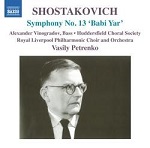 This
is the final release in Petrenko’s series of Shostakovich symphonies:
it formed part of the recent
session from the MusicWeb International Listening Room. Whatever
else, these performances have been a tremendous improvement on their
rather disappointing Naxos predecessors, but can this recording ofBabi
Yar match existing recommendations from Mark Wigglesworth (BIS-SACD-1543: Record of the Year – review)
or, despite less than ideal recording quality, the two all-Russian recordings
from Kyril Kondrashin (Melodiya, complete symphonies: download only
or stream from Qobuz – review) and Gennadi Rozhdestvensky (OCD132 – deleted but
well worth being reissued)?
This
is the final release in Petrenko’s series of Shostakovich symphonies:
it formed part of the recent
session from the MusicWeb International Listening Room. Whatever
else, these performances have been a tremendous improvement on their
rather disappointing Naxos predecessors, but can this recording ofBabi
Yar match existing recommendations from Mark Wigglesworth (BIS-SACD-1543: Record of the Year – review)
or, despite less than ideal recording quality, the two all-Russian recordings
from Kyril Kondrashin (Melodiya, complete symphonies: download only
or stream from Qobuz – review) and Gennadi Rozhdestvensky (OCD132 – deleted but
well worth being reissued)?
The searingly intense Russian performances, especially the Kondrashin,
set the benchmark, despite containing the bowdlerised official version
of the poems. It’s available to download separately from the complete
set from 7digital.com : the five tracks cost £0.99 each and while you are
about it I recommend also purchasing The Execution of Stepan Razin,
the previous track, for the same price, effectively creating an 81-minute
album for £5.94, though too long to burn to CDR. If you remember hearing
the imported Melodiya/MK LP or even the HMV transcription (ASD2893),
the recording has come up sounding remarkably well, with the remaining
rawness appropriate to the music.
With the exception of the second movement, which he takes at quite a
lick, Petrenko is consistently slower than Kondrashin or Rozhdestvensky
and Wigglesworh is slower still except in the third movement and finale.
Their tempo for the opening Babi Yar movement sounds a little
ponderous after Kondrashin and Rozhdestvensky and their soloists don’t
have the sheer hectoring power of their predecessors, though they do
pretty well. The slower tempo at the outset does allow the music to
sound menacing and make the climax all the more of a contrast, but it’s
the men’s choruses that just don’t have the power of the Russians.
At the time of writing classicsonline.com were, surprisingly, offering
only mp3, so I also listened to the 24-bit version from eclassical.com.
At $16.11 that comes at quite a premium over COL’s £4.99 (the 16-bit
costs $10.74, more than the Naxos CD). My colleagues listened to the
CD on high end equipment and were impressed, though they thought the
empty-hall acoustic less than ideal. Listening to the 24-bit download
I was less worried about that, but paradoxically I missed the rawness
of the older recordings – perhaps the RLPO are a little too smooth,
too.
The Ashkenazy complete set of the symphonies remains available at an
attractive price (Decca 4758748), but I thought his swift-paced
version of No.13 one of its least impressive components – review.
The Barshai recording, which I mentioned in that review as the best
bargain version, is now available only as part of the complete set (Brilliant
Classics 6324, around £26). Its place as a single disc at budget
price is now taken by the new Naxos.
 Christmas
Music
Christmas
Music
My first Christmas-themed CDs arrived in mid-September, so I’ve already
fallen behind in reporting on them.
 Baroque
Christmas is a 2-CD set of cantatas and motets for Advent and
Christmas, chiefly by members of the Bach family and Telemann,
and performed by a variety of German ensembles conducted by Werner Erhard,
Herrmann Max, Pal Nemeth and Gerhard Schmidt-Gaden (Capriccio C5217 – from eclassical.com,
mp3 and lossless, with pdf booklet). These recordings have been round
the block several times – dates range from1984 to 2008 – so you may
already have some of them in other collections, but they are none the
worse for that.
Baroque
Christmas is a 2-CD set of cantatas and motets for Advent and
Christmas, chiefly by members of the Bach family and Telemann,
and performed by a variety of German ensembles conducted by Werner Erhard,
Herrmann Max, Pal Nemeth and Gerhard Schmidt-Gaden (Capriccio C5217 – from eclassical.com,
mp3 and lossless, with pdf booklet). These recordings have been round
the block several times – dates range from1984 to 2008 – so you may
already have some of them in other collections, but they are none the
worse for that.
Overall the quality of the music and performances is good but not outstanding.
In some cases there is no alternative: this performance of W.F. Bach’s Lasset uns ablegen, for example, is the only one currently available,
though it’s also to be found on a single Capriccio CD (C10425)
and a 2-CD collection of W.F.’s Cantatas on Brilliant Classics (94256 – review).
UK readers should be aware that they should be able to find the CDs
for around £13, less than eclassical.com’s $24.07.
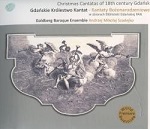 Even
more out of the way than W.F. Bach is Christmas Cantatas of 18th-century
Gdansk, music by Johann Jeremias du GRAIN, Friedrich Christian
MOHRHEIM, Johann Daniel PUCKLITZ and Johann Theodor ROEMHILDT,
performed by the Goldberg Baroque Ensemble/Andrzej Mikolaj Szadejko.
(SARTON002-1 [68:45] – from eclassical.com,
mp3 and lossless, or stream from Naxos
Music Library or Qobuz)
Martin Rin(c)kart is the only familiar name here and that’s only because
Roemhildt uses the familiar words and varies the tune of his well-known
hymn Nun danket alle Gott (Now thank we all our God). The lack
of a book of words is a problem* but everything else about the album
is well worth investigating if you’re tired of the same old same old
for Christmas. Though this is billed as Volume 2, I can’t find Volume
1 anywhere.
Even
more out of the way than W.F. Bach is Christmas Cantatas of 18th-century
Gdansk, music by Johann Jeremias du GRAIN, Friedrich Christian
MOHRHEIM, Johann Daniel PUCKLITZ and Johann Theodor ROEMHILDT,
performed by the Goldberg Baroque Ensemble/Andrzej Mikolaj Szadejko.
(SARTON002-1 [68:45] – from eclassical.com,
mp3 and lossless, or stream from Naxos
Music Library or Qobuz)
Martin Rin(c)kart is the only familiar name here and that’s only because
Roemhildt uses the familiar words and varies the tune of his well-known
hymn Nun danket alle Gott (Now thank we all our God). The lack
of a book of words is a problem* but everything else about the album
is well worth investigating if you’re tired of the same old same old
for Christmas. Though this is billed as Volume 2, I can’t find Volume
1 anywhere.
* Subscribers to Naxos Music Library will find the booklet there, but
no texts.
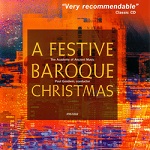
Since I recommended A Festive Baroque Christmas in December
2008, the amazon.co.uk price has risen, though it’s still reasonable
at £6.49. The emusic.com price, too, has risen to £6.30 and neither
is at the full bit-rate. It’s available at the full 320kb/s mp3 or
in lossless sound from eclassical.com.
Though $12.08 may seem a lot to pay for a CD which used to be available
at budget price for around £5, especially when there are no texts, the
music, mostly byHeinrich SCHÜTZ (1585-1672), and the performances
are delectable. (Harmonia Mundi HCX3957202). Stream from Qobuz.
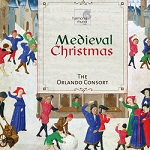
From an earlier period Harmonia Mundi offer Medieval Christmas from the Orlando Consort, ‘an unusual collection of carols ranging from
devotional to boisterous, drawn from a 500-year span of secular and
liturgical music from England, France and the Low Countries’. (HMU907418).
Again, the lack of texts is problematic. This album has been reissued
at lower mid price (HMX2927418, around £9), though you may well
find that, too, lacking in texts, in common with most Harmonia Mundi
reissues at that price. The eclassical.com price of $12.23 for mp3 and lossless still works out slightly less at
mid-October 2014 exchange rates. Stream from Naxos
Music Library or Qobuz.
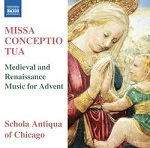 Pierre
de la RUE (c.1452-1518) Missa Conceptio Tua is coupled with
the plainsong Magnificat and its seven ‘O’ antiphons for Advent
together with late medieval English carols, performed by the Schola
Antiqua of Chicago directed by Michael Alan Anderson (Naxos 8.573260 – from
classicsonline.com (mp3 and lossless) or eclassical.com (mp3, 16- and 24-bit lossless). Both include the pdf booklet, with
texts. The classicsonline mp3 costs £4.99, lossless £5.99; eclassical.com
charge $10.35 for mp3 and 16-bit or $15.52 for 24-bit. I listened to
the COL mp3 and the eclassical.com 24-bit.
Pierre
de la RUE (c.1452-1518) Missa Conceptio Tua is coupled with
the plainsong Magnificat and its seven ‘O’ antiphons for Advent
together with late medieval English carols, performed by the Schola
Antiqua of Chicago directed by Michael Alan Anderson (Naxos 8.573260 – from
classicsonline.com (mp3 and lossless) or eclassical.com (mp3, 16- and 24-bit lossless). Both include the pdf booklet, with
texts. The classicsonline mp3 costs £4.99, lossless £5.99; eclassical.com
charge $10.35 for mp3 and 16-bit or $15.52 for 24-bit. I listened to
the COL mp3 and the eclassical.com 24-bit.
The Mass in question is for the Feast of the Immaculate Conception (8
December), so it fits well into the Advent theme. It’s Hobson’s choice
as far as alternatives are concerned – there are none – but this will
serve pretty well, even if it doesn’t quite reach the heights of recordings
of the music of this period by such groups as Gothic Voices (De la Rue, Missa de feria and Missa Dei Genetrix, budget-price Hyperion
Helios CDH55296) The Tallis Scholars or The Sixteen.
Recording of the Month

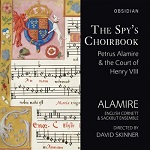 Music
by Pierre de la RUE also features on a new Obsdian recording
with the intriguing title The Spy’s Choirbook. The subtitle
is Peter Alamire and the Court of Henry VIII and the performers
include the group of that name (OBSID-CD712, 2CDs:
Alamire, English Cornett and Sackbut Ensemble/David Skinner, rec. February
2014 [64:20 + 50:48]). Download from
classicsonline.com (mp3, with pdf booklet). Stream fromNaxos
Music Library or Qobuz.
Petrus Alamire prepared a sumptuous choirbook for Henry VIII and Catherine
of Aragon (c.1516) and acted as a spy for the king against Richard de
la Pole, an exiled Plantagenet with a strong claim to the English throne.
Much of the music is anonymous but works by AGRICOLA, JOSQUIN and MOUTON also feature on this Recording of the Month.
Music
by Pierre de la RUE also features on a new Obsdian recording
with the intriguing title The Spy’s Choirbook. The subtitle
is Peter Alamire and the Court of Henry VIII and the performers
include the group of that name (OBSID-CD712, 2CDs:
Alamire, English Cornett and Sackbut Ensemble/David Skinner, rec. February
2014 [64:20 + 50:48]). Download from
classicsonline.com (mp3, with pdf booklet). Stream fromNaxos
Music Library or Qobuz.
Petrus Alamire prepared a sumptuous choirbook for Henry VIII and Catherine
of Aragon (c.1516) and acted as a spy for the king against Richard de
la Pole, an exiled Plantagenet with a strong claim to the English throne.
Much of the music is anonymous but works by AGRICOLA, JOSQUIN and MOUTON also feature on this Recording of the Month.
It’s not specifically for Christmas, but I’ve included it here to point
the difference between the competent performances by the Chicago group
and the Cambridge performers on Obsidian who make the music really come
to life on this, the latest of a series of distinguished recordings
by David Skinner for this label. I enjoyed the Naxos; I was transported
by the Obsidian. As before the recording, made in the Fitzalan Chapel
of Arundel Castle, is very good.
A word of caution for UK readers: you may well find the 2-CD set on
sale for around or slightly less than the price of the COL download
(£15.98). The 7digital.com download costs only £7.99 but I can endorse readers’ problems in sorting
out the tracks from 7digital downloads – they end up in the wrong order
and have to be re-numbered.
If you haven’t yet caught up with the earlier recording in this series Henry’s Music (OBSID-CD705) that’s available from
classicsonline.com (mp3) or eclassical.com (mp3 and lossless). Neither offers the booklet.
 Giovanni
Pierlugi da PALESTRINA (1525/6-1594) Missa Hodie Christus Natus est and other music for Advent and Christmas from Westminster Cathedral
Choir/Martin Baker is a straight reissue of CDA67396 – December
2009 – all the more attractive at the new reduced price on Hyperion
Helios of £4.99 (CDH33657 [78:13] – from hyperion-records.co.uk,
mp3 and lossless, with booklet). Much as I liked the new recording
from The Sixteen (Coro COR16105 – 2012/20) I see no reason to
pay more than the Hyperion price unless you need 24/96 sound.
Giovanni
Pierlugi da PALESTRINA (1525/6-1594) Missa Hodie Christus Natus est and other music for Advent and Christmas from Westminster Cathedral
Choir/Martin Baker is a straight reissue of CDA67396 – December
2009 – all the more attractive at the new reduced price on Hyperion
Helios of £4.99 (CDH33657 [78:13] – from hyperion-records.co.uk,
mp3 and lossless, with booklet). Much as I liked the new recording
from The Sixteen (Coro COR16105 – 2012/20) I see no reason to
pay more than the Hyperion price unless you need 24/96 sound.
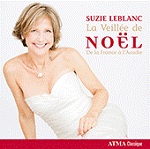
On La Veillée de Noël de la France à l’Acadie Suzie
Leblanc, with varied accompaniment, performs Christmas music taken from
France by settlers to their colony of New France (Acadie) in what is
now Canada (Atma Classique ACD22523 recorded January 2014 [52:12]
– from classicsonline.com,
mp3 and lossless). Back cover only, so no texts, but the booklet with
these can be found at Qobuz.

Lauft, ihr Hirten, allzugleich: Christmas at the Court of the
Salzburg Archbishop (Hänssler Profil PH04092 – rec. c.2003
[62:47]) contains vocal and instrumental music by Michael HAYDN,
Wolfgang Amadeus MOZART, Heinrich BIBER and other less-known composers:
Bernhard Landauer (counter-tenor), Verena Krause (soprano), Martin Steffan
(tenor), Christian Schmidt (bass), Veronica Kroner (violin), Sabine
Lier (violin) and the period-instrument Salzburger Hofmusik are directed
by Wolfgang Brunner. There is no booklet from eclassical.com and Salzburg
is mis-spelled by eclassical.com (mp3 and lossless) and Naxos
Music Library as Salzberg. NML have the booklet but only in truncated
form, with no texts.
This is one mainly for those with a sweet tooth but I guarantee that
most of it won’t be over-familiar and it’s very good of its kind. Very
enjoyable.
 Venetian
Christmas contains mostly music with very tenuous connections
to that season: Antonio VIVALDI contributes the Andante from Il Riposo per il Santissimo Natale, RV270a, the Double Concerto,
RV774 (the first recording of a reconstructed version with psaltery),
the first version of the Violin Concerto in E, RV266, the Salve Regina,
RV617, and
Venetian
Christmas contains mostly music with very tenuous connections
to that season: Antonio VIVALDI contributes the Andante from Il Riposo per il Santissimo Natale, RV270a, the Double Concerto,
RV774 (the first recording of a reconstructed version with psaltery),
the first version of the Violin Concerto in E, RV266, the Salve Regina,
RV617, and 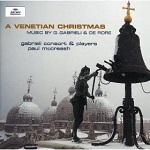 an
aria from Giustino, RV717; Johann Adolf HASSE an Alma
Redemptoris Mater; Fulgenzio PEROTTI a Sonata in G (first recording) and Giuseppe TORELLI concludes the programme
with his Concerto Grosso, Op.8/6. All Venetian but not all particularly
Christmassy: the Torelli and the opening Vivaldi Andante are
the only specifically Christmas works, though Alma Redemptoris Mater is (was) sung at Compline from Advent to Candlemas. Ruby Hughes (soprano),
Ewa Golínska (violin), Komalé Akakpo (psaltery) and L’Arte dei Suonatori
are directed by Martin Geister (BIS-SACD-2089 – rec. October
2013 [74:29] – from eclassical.com,
mp3, 16- and 24-bit lossless, with pdf booklet).
an
aria from Giustino, RV717; Johann Adolf HASSE an Alma
Redemptoris Mater; Fulgenzio PEROTTI a Sonata in G (first recording) and Giuseppe TORELLI concludes the programme
with his Concerto Grosso, Op.8/6. All Venetian but not all particularly
Christmassy: the Torelli and the opening Vivaldi Andante are
the only specifically Christmas works, though Alma Redemptoris Mater is (was) sung at Compline from Advent to Candlemas. Ruby Hughes (soprano),
Ewa Golínska (violin), Komalé Akakpo (psaltery) and L’Arte dei Suonatori
are directed by Martin Geister (BIS-SACD-2089 – rec. October
2013 [74:29] – from eclassical.com,
mp3, 16- and 24-bit lossless, with pdf booklet).
For a real Venetian Christmas try the DG Archiv recording
of that title on which the Gabrieli Consort and Players are conducted
by Paul McCreesh (4713372 – review – download only: from prestoclassical.co.uk, mp3 and lossless). Stream from Qobuz.
